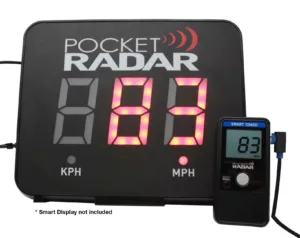Are you curious about how fast can the average person throw a baseball? Witnessing the amazing speed with which pitchers launch the ball towards home plate is one of the most thrilling sights in the world of baseball. The velocity with which professional players throw often take spectators by surprise. However, for those of us who do not play professional baseball, the issue remains: how fast can an average person throw a baseball? It's an engrossing question that arouses curiosity and a want to learn more about the ability of ordinary people when it comes to unleashing their throws. In this post, we will explore the domain of typical throwing speeds, evaluate the numerous aspects that determine velocity, and present useful ideas and insights to help you improve your own throwing abilities. So put on your trusty mitt, take your place on the pitcher's mound, and enter the enthralling world of baseball tossing!
How Fast Can the Average Person Throw a Baseball?
 Throwing speed in the normal person can vary substantially based on factors such as age, gender, athletic ability, and training. An untrained adult male can throw a baseball at speeds ranging from 45 to 65 miles per hour (mph), whereas an untrained adult female can throw at speeds ranging from 30 to 45 mph. These values, however, are only estimations and individual talents may vary.
Throwing speed in the normal person can vary substantially based on factors such as age, gender, athletic ability, and training. An untrained adult male can throw a baseball at speeds ranging from 45 to 65 miles per hour (mph), whereas an untrained adult female can throw at speeds ranging from 30 to 45 mph. These values, however, are only estimations and individual talents may vary.
It's worth noting that these speeds are substantially lower than those attained by professional baseball players, who can throw the ball at rates exceeding 90 mph. Professional pitchers receive extensive training and use unique strategies to increase their pitching speed. Don't be discouraged if you can't match their speed. You may still increase your throwing speed and accuracy with proper training and practice.
Throwing Velocity Influencing Factors
 An average person's throwing velocity can be influenced by a number of critical elements. Let us examine each of these aspects in greater detail:
An average person's throwing velocity can be influenced by a number of critical elements. Let us examine each of these aspects in greater detail:
- Mechanics and Technique: The method you throw a baseball has a big impact on how fast you can go. Body placement, arm motion, and weight transfer are all part of proper technique and mechanics. For example, using your entire range of motion in your throwing arm and producing power from your lower body can both contribute to improved velocity.
- Power and Conditioning: Having a strong and well-conditioned body will help you throw better. Through targeted exercises, you can improve the power and speed of your throw by strengthening your core, upper body, and arm muscles. Regular strength and conditioning regimens can also help to lower the chance of injury.
- Range of Motion and Flexibility: Flexibility is essential for throwing a baseball effectively. A smooth and efficient throwing motion requires a good range of motion in your shoulders, hips, and thoracic spine. Stretching and mobility exercises can assist improve flexibility and maximize your throwing potential by including them into your training program.
- Grip and Let Go: The manner you grip and release the baseball can affect its trajectory and speed. Experimenting with different grips to find one that feels comfortable and allows you to maintain adequate control will help you improve your throws. Experiment with various releases to find the most efficient and accurate method for you.
- Mental Concentration and Self-assurance: Throwing a baseball necessitates mental concentration and confidence. Trusting your ability, remaining calm under pressure, and focusing on your aim can all help you throw more powerfully and accurately. Practicing mindfulness techniques and developing mental tactics can help you perform better on the field.
If you are interested in learning how to throw harder checkout the 3X Pitching Velocity Program!
Throwing Speed Improvement Techniques
 Now that we've covered the components that determine throwing velocity, let's look at some techniques for improving your throwing speed:
Now that we've covered the components that determine throwing velocity, let's look at some techniques for improving your throwing speed:
- Consistent practice: Consistent practice is required to improve your throwing ability. Make time for regular throwing sessions to improve your strength, muscle memory, and technique. Begin with small distances and then expand them as your abilities develop.
- Include Strength Training: Including strength training activities in your fitness routine can improve your throwing speed dramatically. Exercises that target the muscles involved in throwing, such as shoulder presses, rows, and core exercises, should be prioritized. Consult with a fitness specialist to design a program that is specific to your needs.
- Improve your flexibility and mobility: Improving your flexibility and mobility can help you throw more fluidly and powerfully. Stretching exercises for the shoulders, hips, and thoracic spine should be included in your warm-up and cool-down routines. Consider doing yoga or Pilates to increase your general flexibility.
- Seek Professional Guidance: If you're serious about improving your throwing speed, consult with a professional coach. They can assess your technique, identify areas for development, and provide tailored drills and exercises to help you perform better. Working with a coach can help you make faster progress and avoid harmful habits.
- Visualize Yourself Succeeding: Visualization is a fantastic technique for improving your throwing ability. Before each throw, take a few moments to picture a successful and accurate toss. Imagine the ball exiting your hand quickly and precisely, reaching your target. This mental practice can boost your confidence and performance on the field.
- Maintain Consistency and Patience: It takes time and effort to improve one's throwing speed. Maintain consistency in your practice, stick to a set training schedule, and be patient with your improvement. Keep in mind that everyone develops at their own speed, and consistent work will produce results over time.
FAQs: How Fast Can the Average Person Throw a Baseball
- Can a person's throwing speed improve with age?
Yes, with proper training and repetition, anyone of any age may enhance their throwing speed. While younger people may have a modest advantage due to inherent athleticism, adults can improve their throwing ability with targeted training and technique refining. - Are there any specific drills that may be used to improve throwing speed?
Yes, there are various drills that can help you improve your throwing speed. Long tosses, weighted ball throws, and interval training focused on explosive motions are all excellent activities. These exercises can help you increase your arm strength, speed, and throwing mechanics. - Can women throw as hard as men?
Males have stronger upper body strength and muscular mass on average, which can lead to faster throwing rates. Females can, however, acquire outstanding throwing velocities with correct training and technique. It is critical to focus on individual growth rather than comparing performance purely on the basis of gender. - Is throwing technique important in determining throwing speed?
Absolutely. Throwing technique is critical for increasing throwing speed and accuracy. Body alignment, arm motion, and weight transfer can all help you generate more power and efficiency in your throws. - Are there any frequent blunders to avoid when attempting to increase throwing speed?
Yes, some frequent blunders to avoid when attempting to enhance throwing speed are overexertion without adequate rest, ignoring strength and flexibility exercises, and failing to practice good throwing mechanics. To reduce the risk of injury and achieve optimal outcomes, it is critical to create a balance between training, rest, and keeping good technique. - How long does it take for throwing speed to improve?
The time it takes to observe increases in throwing speed varies depending on the individual. With constant practice and dedicated training, you can notice results in a matter of weeks or months. Significant improvements, on the other hand, may take several months to a year or more, depending on individual characteristics and commitment to training.




Trackbacks/Pingbacks